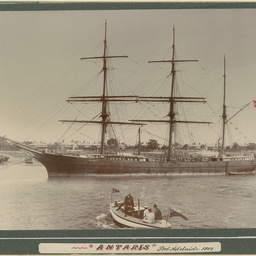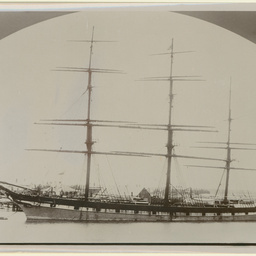Find • port adelaide • Results 6,301 to 6,330 of 10,005


S.V. Inca
S.V. Inca at anchor at Port Adelaide with a load of timber, photographed February 10, 1904.


S.S. "Karoola"
S.S. "Karoola" steel twin screw steamer built in Belfast in 1909 for voyages between Port Adelaide and Fremantle. Requisitioned during WW1 as a troopship, hospital ship. Returned to passenger service in 1919. Laid up in Sydney in 1936.


H.M.S. "Protector"
H.M.S. "Protector" was a large flat-iron gunboat commissioned and purchased by the South Australian government in 1884 for the purposes of protecting the local coastline from Russian attacks. She was launched in 1884. In 1910 she was acquired by the Commonwealth for the Royal Australian Navy and served during World War I. Archivist note on back of photograph suggests this photograph was taken on the occasion of her return from China after the Yihetuan Movement (Boxer Rebellion) This was the trade inbalance between China, United States, Europe and particularly Great Britain. HMS "Protector" arrived back in Port Adelaide in 1901 to much fanfare. The AW Sandford warehouse can be seen in the background.


Royal Yacht "Ophir"
The Royal Yacht "Ophir" at Port Adelaide. RMS Ophir was a twin screw ocean liner of the Orient Steam Navigation Company of London and in 1901 she served as the Royal Yacht HMS Ophir taking the Duke and Duchess of Cornwall (the future King George V and Queen Mary) and on their tour of the British Empire.


Craigendarroch
A model of the Craigendarroch ship of 991 tons register. Launched April 2, 1870. Photographed and modelled by Patrick Weir, June 1928. This wooden ship was built in Aberdeen in 1870, 991 tonnage and made five voyages between London and Port Adelaide between 1874 and 1878. She was wrrecked in the Philippines in 1882.


Thomas C. Harrison
Thomas C. Harrison, ship left London via Deal, Kent and arrived in Port Adelaide on 25 February 1839 carrying 95 passengers and colonists.


"Sunbeam"
Lord Brassey's yacht "Sunbeam" at Port Adelaide.


H.M.S. Opal
H.M.S. Opal was an Emerald class corvette of the Royal Navy launched in 1875. She commenced service on the Australian Station in 1885. The photograph shows the crew standing on the four cross spars in the rigging on two of the three masts of the ship while she is moored near the wharf at Port Adelaide.


The 'Dimsdale'
[General description] The 'Dimsdale', a steel ship built 1890 by C.J. Bigger of Londonderry. She became notorious when she struck the Wonga Shoal Lighthouse near Port Adelaide on 17th November, 1912, destroying the structure and drowning the two lighhouse keepers on duty.


The "Ardencraig"
The "Ardencraig" was a 556 ton barque The ship visited Port Adelaide from London via Portsmouth in June 1873. Jonathan Rennie Stuart was the master. Elder Smith and Company were the agents


The "Antares"
The "Antares" iron ship built in 1888 and wrecked off the south west coast of Victoria in 1914. The ship was sailing from Marseilles to Melbourne via the southern Australian coastline when it came to grief on a rocky outcrop near Peterborough with a loss of all crew. Originally named "Sutleg", renamed "Antares"by Italian owners


The "Ardencraig"
The "Ardencraig" was a 556 ton barque The ship visited Port Adelaide from London via Portsmouth in June 1873. Jonathan Rennie Stuart was the master. Elder Smith and Company were the agents


The "Bonvento"
The "Bonvento" of Norway, built 1892 in Grimstead, three masted steel barque. She was the last sailer to load wool at Port Adelaide


The "Eurydice"
The "Eurydice" ffrom Gottenburg visited Port Adelaide in 1873. The Master was Henry Lewis Carr. In 1875 she was refitted by the Royal Navy as a training vessel for second class ordinary seamen. In 1878 she foundered with a loss of over three hundred lives


The "Ganymede"
The "Ganymede" was an iron barque, 569 tons, built in 1868 in Sunderland. Owner and Captain was Thomas Thompson. She visited South Australia in 1870 and 1877 before being acquired by Port Adelaide owners in 1880


The "Great Britain"
The steam ship "Great Britain" arrived in Port Adelaide April 16th, 1869. The Captain was Lieutenant John Gray, RNR Commander. "Great Britain" carried thousands of immigrants from Liverpool to Australia from 1852 until she was converted to sail in 1881. She completed 32 round voyages to Australia


Unidentified vessel
Unidentified vessel previously thought to have been the "Hesperus" which was a three masted iron ship, built at Greenock in 1873, 1859 gross tons. She made five voyages from London to Port Adelaide between 1882 and 1886. The vessel in the photograph at Gravesend in approximately 1885 is, however, a four masted barque rigged vessel.


The "Hinemoa"
The schooner "Hinemoa" was built at Greenock for the New Zealand Government. She visited Port Adelaide in October 1876 and proceeded to be placed on the patent slip for scraping and recoating. The ship has a long low hull with full cutwater and a figurehead forwards, beautiful lines, and most symmetrical proportions with deep undercut run so as to give the propeller full power on clear water.


The "Lake Erie"
The "Lake Erie" iron barque, 988 tons built in 1868 in Glasgow. The owners were The Canada Shipping Company. The ship is seen here moored at the wharf at Port Adelaide beside the Wool Stores. The ship visited South Australia in 1885, 1896, 1899 and 1900


The "Lake Superior"
The "Lake Superior" iron ship, built in Greenock in 1868, 1335 gross tons. The ship visited Port Adelaide in 1890, 1891, 1895, 1898, 1900


The "Letterewe"
The "Letterewe", 820 tons, three mast barque built in Liverpool. She had various name changes and was later added to the Black Star Line and sailed the Australia route. This photograph shows her at Port Adelaide in approximately 1904


The "Loch Bredan"
The "Loch Bredan" iron barque, 982 tons, 3 masts, built in 1882 in Glasgow, registered in Liverpool. Visited South Australia in 1885. Last seen in September 1903 on homeward bound voyage from Port Adelaide to Capetown with bales of compressed fodder. Captain Williams was accompanied by his wife on that passage. Lost with all hands.


The "Loch Bredan"
The "Loch Bredan" iron barque, 982 tons, 3 masts, built in 1882 in Glasgow, registered in Liverpool. Visited South Australia in 1885. Last seen in September 1903 on homeward bound voyage from Port Adelaide to Capetown with bales of compressed fodder. Captain Williams was accompanied by his wife on that passage. Lost with all hands.


The "Loch Etive"
The 'Loch Etive'.


The "Margarita"
The "Margarita". This wooden three mast of 494 tons schooner arrived in Port Adelaide from Mauritius in 1899


The "Melanope"
The "Melanope" visited South Australia in 1895 and 1896. Shown here in Port Adelaide. She was an iron ship, 1686 tons, built and registered in Liverpool. She was abandoned after going on her beam ends off the west coast of Canada in 1907, and drifted into the Columbia River. Later converted to a coal hulk


The "Mermerus"
The "Mermerus" visited South Australia in 1899. The iron ship weighing 1671 tons was registered in Glasgow but sold to Russian owners. She was one of the best known clippers in the Australian wool trade. She arrived at Port Adelaide and The Semaphore on four voyages from 1898 to 1908


The "Mermerus"
The "Mermerus" visited South Australia in 1899. The iron ship weighing 1671 tons was registered in Glasgow but sold to Russian owners. She was one of the best known clippers in the Australian wool trade. She arrived at Port Adelaide and The Semaphore on four voyages from 1898 to 1908


The "Omega"
The "Omega". Iron four masted barque, 2471 tons, built in 1887. Made one voyage from England to Port Adelaide in 1898.


The "Rothesay Bay"
The "Rothesay Bay" was an iron three mast barque built in Dumbarton in 1877, 762 tons. She visited Port Adelaide four times from 1881 to 1920. Ended her days as a coal hulk in New Zealand
